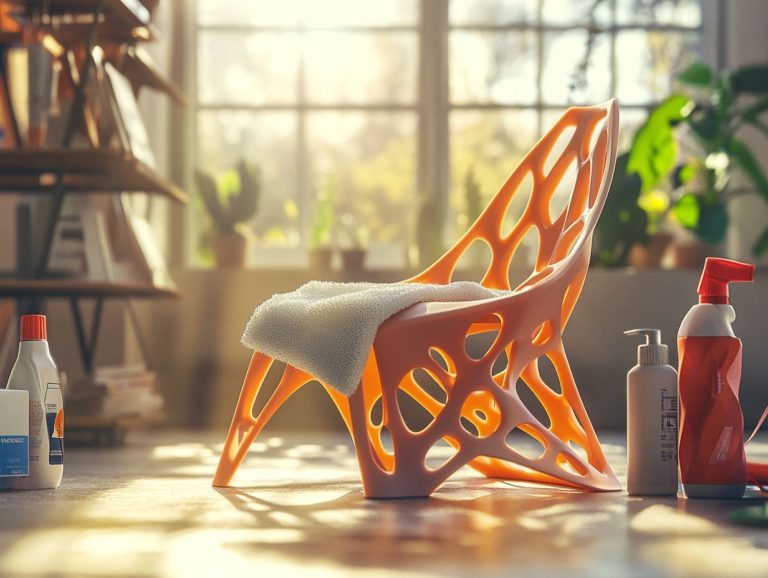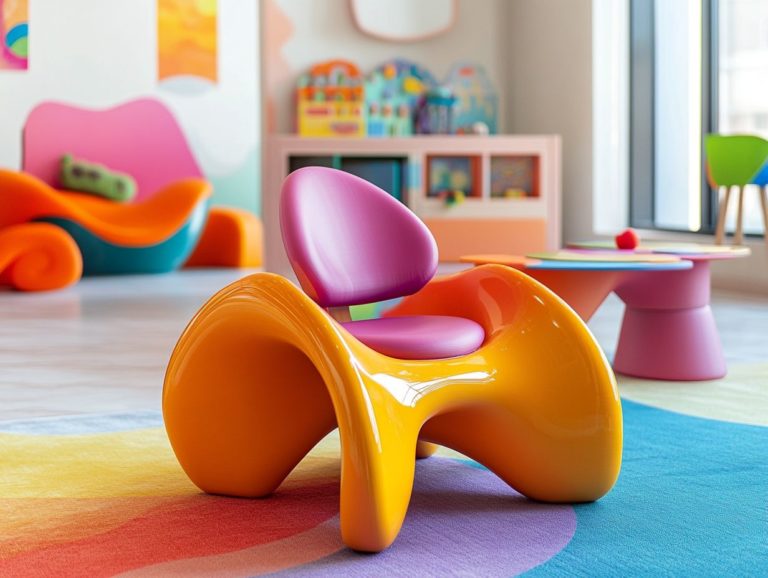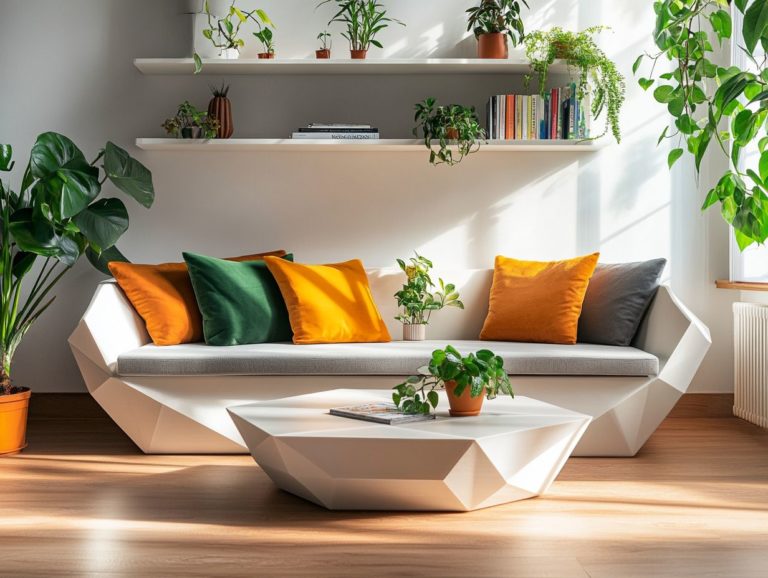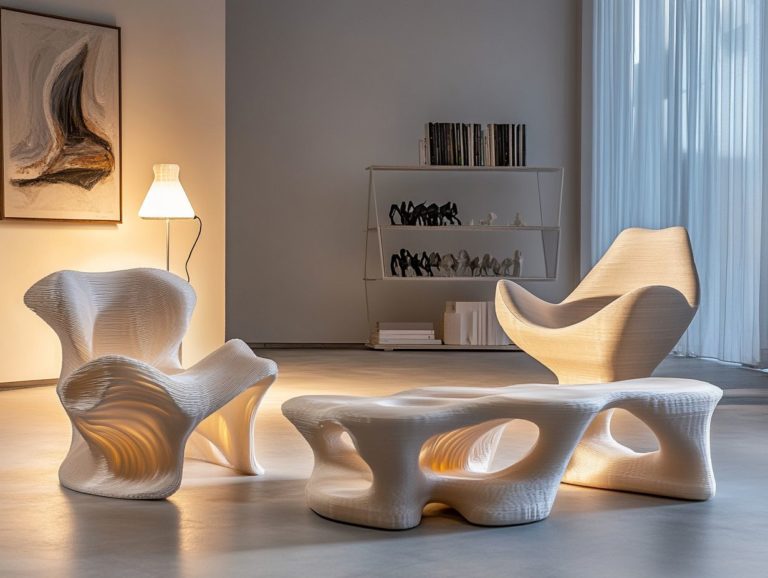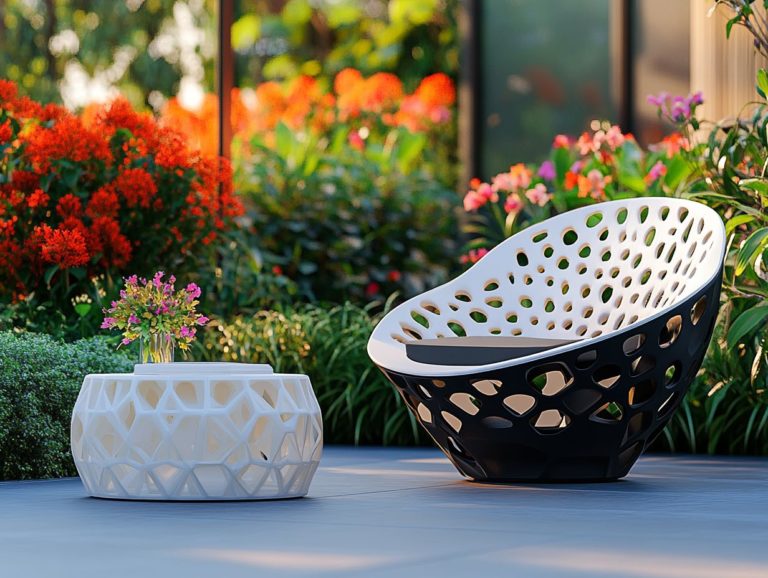5 Ways 3D-Printed Furniture Can Save You Money
In today s fast-paced world, innovative solutions are redefining your furniture experience.
3D printing stands at the forefront of this transformation, presenting a remarkable combination of affordability, customization, and sustainability. Picture crafting furniture that seamlessly fits your space without the burdensome costs associated with traditional methods.
Get ready to discover five exciting ways 3D-printed furniture can enhance your finances, from cutting out shipping costs to reducing material waste. Explore how this groundbreaking technology has the potential to reshape your home and your budget.
Contents
- Key Takeaways:
- 1. No Need for Expensive Tools or Equipment
- 2. Customizable to Fit Your Space and Needs
- 3. Eliminates Shipping and Delivery Costs
- 4. Reduces Material Waste and Cost
- 5. Can Be Repaired and Modified Easily
- How Does 3D Printing Work for Furniture?
- What Are the Different Types of Materials Used in 3D-Printed Furniture?
- What Are the Limitations of 3D-Printed Furniture?
- Discover How to Make 3D-Printed Furniture Eco-Friendly!
- What Are the Different Designs and Styles Available for 3D-Printed Furniture?
- What Are the Potential Cost Savings of 3D-Printed Furniture in the Long Run?
- Frequently Asked Questions
- How can 3D-printed furniture save me money?
- What are some other ways 3D-printed furniture can save me money?
- Is the quality of 3D-printed furniture comparable to traditional furniture?
- Can I save money by 3D-printing my own furniture at home?
- Are there any environmental benefits to using 3D-printed furniture?
- What are some examples of 3D-printed furniture that can save me money?
Key Takeaways:

- No need for expensive tools or equipment: 3D-printed furniture eliminates the need for costly tools and equipment, making it a cost-effective option for furnishing your home.
- Customizable to fit your space and needs: With 3D-printed furniture, you can easily customize the design and size to fit your space and specific needs.
- Eliminates shipping and delivery costs: You can simply print the pieces yourself, eliminating the need to pay for expensive shipping and delivery fees.
1. No Need for Expensive Tools or Equipment
The rise of 3D printing, especially with open-source models like RepRap, has fundamentally transformed the manufacturing landscape. You no longer need costly tools or equipment this innovation is accessible to everyone, from enthusiastic hobbyists to professional materials engineers and product developers at esteemed institutions like Michigan Technological University.
This shift encourages you to take a hands-on approach to production, igniting your creativity and sparking innovation. With affordable open-source printers at your fingertips, you can explore unique designs tailored specifically to your needs, all without the financial strain typically associated with traditional manufacturing methods.
As a result, consumer behavior is evolving; more individuals are pursuing personalized products, leading to substantial cost savings compared to mass-produced alternatives. This easier access to making products not only fosters self-sufficiency but also gives you the power to create high-quality prototypes and finished goods right from the comfort of your home, effectively blurring the lines between consumer and producer.
2. Customizable to Fit Your Space and Needs
One of the standout benefits of 3D printing is its remarkable ability to create customized designs tailored specifically to your space and needs. This technology offers you unparalleled design freedom, especially when learning how to incorporate 3D-printed furniture in small spaces, making it ideal for crafting furniture models suited for any environment.
With this innovative approach, designers can seamlessly blend creativity with practicality, producing bespoke furniture pieces that fit perfectly into your room and resonate with your personal style. Thanks to Computer-Aided Design (CAD), making precise adjustments is easy, ensuring that every dimension aligns flawlessly with your requirements.
This level of customization prioritizes both functionality and aesthetics, resulting in unique items that serve specific purposes and make a statement be it a compact desk for your small home office or a striking centerpiece that elevates your living area.
3. Eliminates Shipping and Delivery Costs
By embracing 3D printing, you can significantly cut down on shipping and delivery costs, as products can be crafted on demand right in your own home or at local digital marketplaces.
This new approach eliminates long wait times tied to traditional shipping and dramatically reduces overall manufacturing expenses. When goods are produced closer to you, it lessens the need for extensive warehousing and transportation, thereby streamlining the entire supply chain.
This local production model has the potential to boost community resilience by nurturing a more sustainable economy. By shortening the distance products travel, you lower the carbon footprint, contributing to a healthier environment and paving the way for eco-friendly manufacturing practices.
4. Reduces Material Waste and Cost

3D printing technology allows you to significantly reduce material waste and costs through its additive manufacturing (building objects layer by layer) processes. This approach enables precise production while minimizing excess and tackling various design challenges.
This innovative production method is transforming industries by slashing energy consumption compared to traditional techniques. For example, a prominent automotive manufacturer successfully embraced 3D printing to create lightweight components, achieving a remarkable reduction in energy costs by nearly 30%.
In the aerospace sector, where every ounce of material can influence flight efficiency, this production method has been nothing short of revolutionary. Companies have reported a staggering decrease in scrap material; one leading aerospace firm managed to cut waste by up to 60% by shifting to additive manufacturing. This clearly showcases the environmental advantages that 3D printing technology brings to modern industry.
5. Can Be Repaired and Modified Easily
One of the standout features of 3D printing is its remarkable ability to easily repair and modify products. This makes it an enticing choice for consumers who value personalized items that fit their needs over time.
This capability fundamentally shifts how you perceive products throughout their life cycles, allowing for a more sustainable approach to consumption. Consider everyday items like smartphone cases, kitchen utensils, and even furniture parts. With 3D-printed components, you can effortlessly upgrade or repair them.
When your favorite mug cracks, instead of tossing it aside, you can mend it. If a child’s toy is missing a piece, you can reimagine it rather than simply replace it. This extends the life of your belongings and boosts your satisfaction as you forge a connection with items that reflect your personal style and needs.
How Does 3D Printing Work for Furniture?
3D printing offers you the ability to create intricate furniture models through advanced prototyping techniques and innovative manufacturing processes. This results in high-quality products that cater to a variety of consumer preferences.
Your journey begins with a comprehensive design phase, where you use specialized software to craft unique pieces that are visually stunning and functional. Once you’ve finalized a design, the prototyping stage kicks off, allowing you to bring a physical model to life for evaluation.
During this crucial phase, selecting the right materials is essential, as it can significantly impact both the strength and appearance of your final product. With advanced printing technologies like multi-material 3D printing at your disposal, you can enhance the versatility of your designs, seamlessly blending different textures and colors.
Ultimately, the integration of these elements leads to final production that satisfies not only aesthetic desires but also ensures durability, resulting in greater consumer satisfaction.
What Are the Different Types of Materials Used in 3D-Printed Furniture?
In the realm of 3D printing for furniture, you have a diverse array of materials at your disposal. These include FDM, SLA, SLS, and PolyJet technologies. Each of these methods offers its own advantages when it comes to durability, aesthetics, and functional properties.
These technologies leverage materials like thermoplastics, resins, and metal powders. Each material contributes unique characteristics. For example, FDM typically employs thermoplastics that are both tough and lightweight. This makes them perfect for functional prototypes. SLA printing, on the other hand, offers precision that results in smooth finishes and intricate details, ideal for high-end furniture designs.
SLS takes it a step further by using powdered materials. This grants designers greater freedom and the ability to create more complex geometries. Meanwhile, PolyJet shines with its superior color vibrancy and exceptional surface finishes, catering to aesthetic demands without compromising functionality.
By understanding these material properties, you can make informed decisions that shape the quality and usability of your final product.
What Are the Limitations of 3D-Printed Furniture?

Despite its revolutionary potential, 3D-printed furniture has a few limitations. Design challenges arise with complex shapes, and production volume constraints can impact manufacturing scalability.
Material limitations are another significant hurdle. Current 3D printing materials may not match the durability or aesthetic appeal of traditional options. This raises concerns about how strong the furniture is and its longevity.
Production speed is also a critical factor. The time required to create larger pieces can deter manufacturers from fully embracing this technology for commercial use.
By tackling these challenges with innovative materials and enhanced printing techniques, the industry could witness a remarkable rise in the adoption and mainstream acceptance of 3D-printed furniture.
Discover How to Make 3D-Printed Furniture Eco-Friendly!
You can make 3D-printed furniture eco-friendly by choosing sustainable materials, minimizing waste, and reducing energy use throughout the production process. For more ideas, check out this guide on how to decorate with 3D-printed furniture. This approach highlights the potential for environmentally conscious design that truly makes a difference.
Incorporating biodegradable materials into the printing process ensures that your products break down naturally, reducing their long-term impact on the environment. Plus, the energy-efficient nature of 3D printing means it consumes less power than traditional manufacturing methods, positioning it as a more sustainable alternative.
Digital designs are key in this process, allowing you to easily modify and update your creations. This capability promotes resource reuse and enhances recycling opportunities. Embracing this strategy supports sustainable practices while inspiring innovation in crafting furniture that is both stylish and kind to the planet.
What Are the Different Designs and Styles Available for 3D-Printed Furniture?
The furniture industry has fully embraced 3D printing. It showcases a remarkable array of designs and styles that demonstrate the technology s capacity to create customized products tailored to your unique tastes and preferences.
With innovative techniques available, designers are crafting distinctive pieces that blend functionality with artistic expression. Imagine organic shapes inspired by nature, offering a fresh twist on traditional furniture. At the same time, geometric patterns echo the elegance of modern minimalism.
This versatility ensures that whether you seek a sleek side table or an intricately designed chair that serves as a striking conversation starter, you ll find options that resonate with your aesthetic. The opportunity to experiment with various materials and finishes enhances creativity, guaranteeing that the final product meets your practical needs and aligns perfectly with your vision.
What Are the Potential Cost Savings of 3D-Printed Furniture in the Long Run?
Investing in 3D-printed furniture offers fantastic savings. By reducing manufacturing expenses and optimizing inventory management, you set yourself up for success.
By minimizing the need for extensive warehousing and embracing producing items as needed, you can effectively lower those pesky overhead costs that often burden traditional furniture manufacturing.
For example, a small startup recently reported an impressive 40% reduction in material waste thanks to 3D printing, highlighting the potential for increased profitability.
A renowned furniture retailer found that 3D-printed products not only streamlined their supply chain but also empowered them to swiftly adapt to market trends. This agility allows them to meet customer demands without overcommitting resources.
These examples show how embracing this technology can lead to substantial financial advantages in today s fiercely competitive landscape.
Frequently Asked Questions
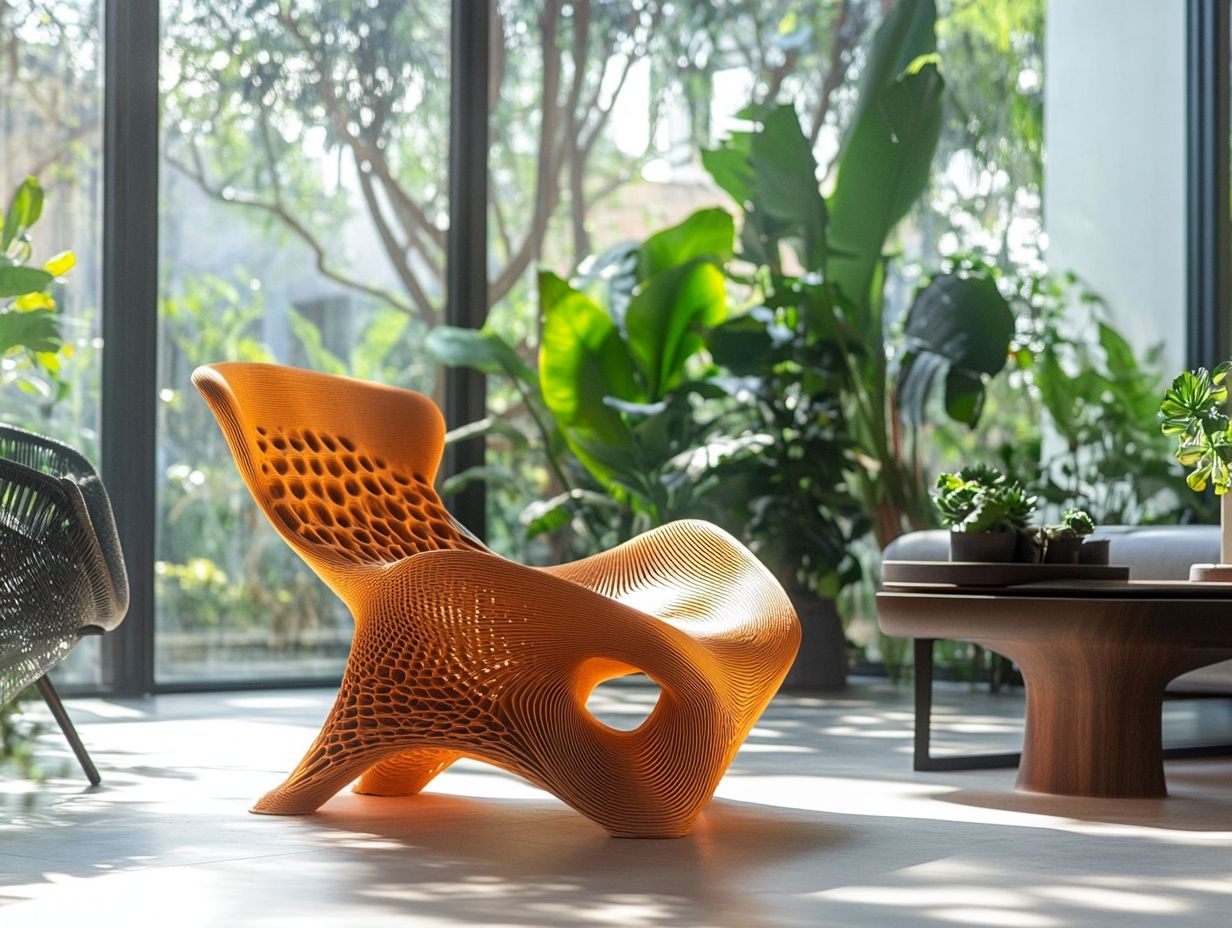
How can 3D-printed furniture save me money?
3D-printed furniture cuts costs on materials and labor compared to traditional methods. Additionally, it offers innovative ways to enhance your home. For tips on incorporating these modern pieces, check out how to style your space with 3D-printed furniture, which also allows for more efficient use of materials, reducing waste and cost.
What are some other ways 3D-printed furniture can save me money?
Aside from lower production costs, 3D-printed furniture saves you money in shipping and storage. Its lightweight and compact design makes it easier and cheaper to transport and store, but it’s important to consider the cost of 3D-printed furniture and whether it’s worth it.
Is the quality of 3D-printed furniture comparable to traditional furniture?
Yes, thanks to advancements in technology, 3D-printed furniture can now match the quality and durability of traditional furniture. It undergoes rigorous testing and can even be customized to meet your specific needs and preferences.
Can I save money by 3D-printing my own furniture at home?
Yes, investing in a 3D printer for your home can save you money in the long run. You can download and print designs for free or at a low cost, and you have the option to make repairs or replacements yourself. For inspiration, you might want to discover unique 3D-printed furniture concepts instead of buying new furniture.
Are there any environmental benefits to using 3D-printed furniture?
Yes, 3D printing is revolutionizing furniture design by making furniture more sustainable, as it uses less material and reduces waste compared to traditional furniture production. It also has a smaller carbon footprint since it can be locally produced and shipped.
What are some examples of 3D-printed furniture that can save me money?
Some examples of 3D-printed furniture that can save you money include chairs, tables, bookshelves, and storage units. These can be printed in various designs and sizes, and can also be easily personalized. Discover the benefits of customized 3D-printed furniture to fit your budget and style.
Discover how 3D printing can transform your furniture shopping experience today!

